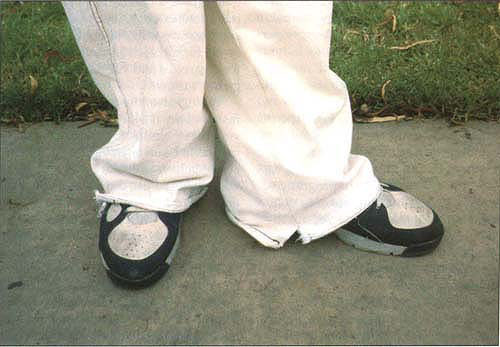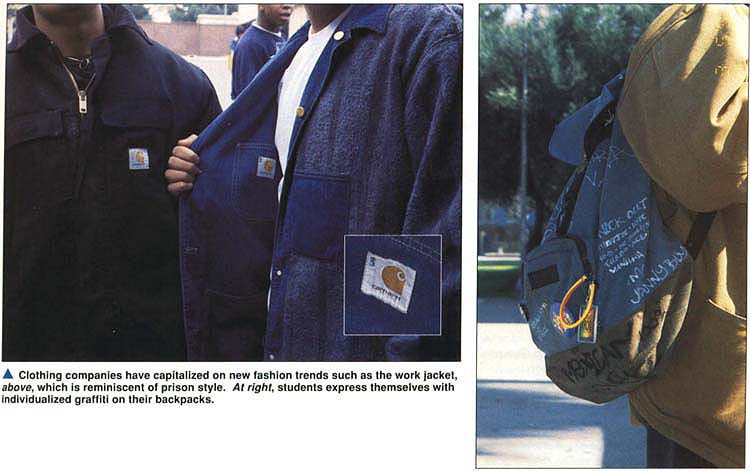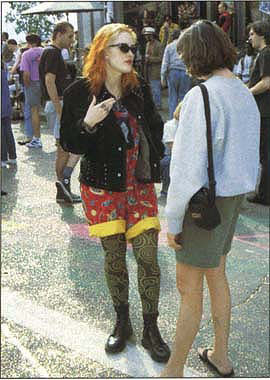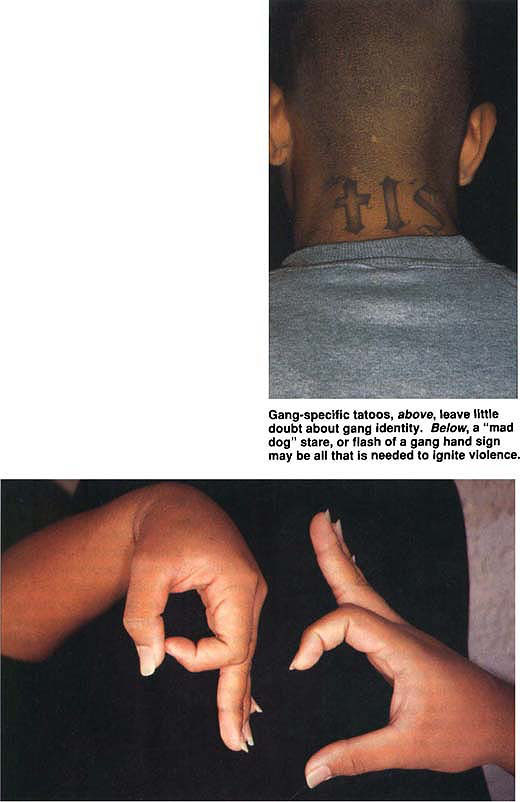All Issues
Gang identity or self-expression? Researchers look beyond the surface of “gang clothing” and appearance
Publication Information
California Agriculture 48(7):44-48.
Published December 01, 1994
PDF | Citation | Permissions
Abstract
Baggy pants, a red bandana, a long belt hanging from the waist: Signs of gang identity or merely expressions of emerging identity? As problems of gang behavior escalate and spread, the need to understand gang identity through clothing and appearance becomes critical. Do dress codes alleviate gang-related problems? Or do they create other problems? The way we present ourselves is a silent form of communication that is as often creatively benign as it is potentially dangerous.
Full text
Styles that once were a symbol of potential danger and violence have crossed over into the mainstream. An example, at left, is the ripped pants hem, which once was a sign of gang identify but now is a benign fashion statement.
As problems of gang behavior escalate in urban settings and spread to suburban and rural areas, the need to understand gang identity through clothing and appearance becomes critical. Whether an appearance represents gang identity or simply an adolescent expression of style has become a central question in the search for safe solutions to gang violence. The “meaning” of clothing choices has recently become a hot issue for public discussion, not just as it relates to gang identity but as it otherwise defines an individual in society. What we look like and how we choose to present ourselves is a silent form of communication.
The looks and clothing choices that teenagers use to express themselves are often considered outrageous by others. This pattern can be seen throughout recent history; those who are adults today may recall adolescents of the 1960s whose granny glasses, bellbottoms, and other clothing choices were deprecated by adults of that time. Today, however, it might be argued that the stakes are higher. Clothing has been closely linked to violent and sometimes deadly situations. Kids may be at risk because of their clothing choices.
This connection between clothing and violence expresses itself in several ways:
-
Gang members may start a fight, or shooting, by signaling their readiness through clothing and appearance cues.
-
Kids who are not gang members are at risk of being hurt or becoming unwilling participants in gang violence if their clothing or body actions are visually mistaken to be those of a gang member.
-
Clothing or accessories, such as expensive athletic shoes, have become the targets of robbery and violence.
In some cases, the person wearing the item has been hurt or even killed.
All of these are real situations that occur with increasing frequency. This strong connection between clothing and violence is unprecedented. The public reaction has been one of fear, alarm, and desperation. This has caused considerable interest in wanting to know how to recognize the visual indicators of gang identity.
In reponse to this concern, one solution has been to control clothing and appearance choices. Schools around the country have begun to impose dress codes in an attempt to provide safer environments for their students. Legislation passed the California Assembly and was signed into law making it possible for schools, beginning January 1994, to impose dress codes specifically for the purpose of eliminating gang-related clothing. The assembly bill allows individual school districts to determine what clothing and appearance practices constitute “gang identity” at their location. However, no training or materials exist on how to determine this or how to maintain a broad range of self-esteem issues in the process. In an even more drastic step, California lawmakers in 1994 passed a bill giving public school districts the power to require that their students wear uniforms.
Clothing companies have capitalized on new fashion trends such as the work jacket, above, which is reminiscent of prison style. At right, students express themselves with individualized graffiti on their backpacks.
On the surface, these may seem like positive solutions to the potentially explosive problems of gang violence and gang identity. However, many hidden issues are ignored in a strategy that seeks simply to control appearance. In fact, there may be side effects from these decisions that create even further dangers. The desire to define self through clothing and appearance is basic to social and psychological needs, such as self-esteem, personal expression and group identification. Are there risks involved in limiting opportunities to explore identity and creative expression at a time when the self is emerging? When a dress code or uniform is chosen, whose aesthetic rules? The danger of discrimination in this situation is real. With the many ethnicities and wide racial mix in California's public schools, clothing is a natural vehicle for the expression of cultural diversity. Do dress codes eliminate clothing practices that are common only among minority groups? In the rush to provide solutions to problems, the need for informed decisions must take precedence over “knee-jerk” reactions.
Gaining perspective
This research began as a response to the need to explore the issue of gang identity and adolescent style. The main objective was to document and understand the changing nature of gang identity within the broader context of street style and adolescent expression. This approach included observations and interviews in street and school settings throughout California and in selected cities nationwide. By working with law enforcement agencies, access was provided through “ride-alongs” to locations that would otherwise be unavailable. Schools cooperated by allowing access for interviews with students from a wide variety of backgrounds. Urban, rural and suburban areas were included. Attempts were made to include a broad ethnic mix of students. We also tried to include a sampling of different schools, ranging from one Los Angeles County school with a student population of 2,200, of which approximately 80% were gang members, to a much smaller school in rural northern California, where the gang phenomenon is just beginning to manifest itself.
Photographs were taken to document clothing and appearance choices. At times, students were given cameras to assist in the data collection. Focus group interviews were held to learn more about the visuals collected. An image database is being developed that includes approximately 500 slides depicting adolescent expressions of style and examples of gang identity.
Another former symbol of gang identity which has become popular with mainstream teens is the long hanging belt, at left. At one time, the belt was considered a gang identifier, especially when coupled with a particular buckle. Many schools have banned the “bagging and sagging” look, above, because of its gang-related image. But for many, it's simply a matter of style.
Throughout the study, the focus has been on understanding the clothing choices and expressive nature of gang members, as well as adolescents who are not in gangs. The purpose is to develop an awareness of the issues affecting our ability to identify the visual cues of gang identity. We also hope to provide a problem-solving framework to aid in understanding the bigger picture.
The picture of a gang member
As with all adolescents, gang members tend to arrange their appearances in ways that express who they are. However, often embedded in their appearance are cues that signal their specific gang identity. The key is to be able to identify what is gang specific and what is simply representative of current adolescent fashion trends. This is not easy. Simply providing a list of visual factors that contribute to gang identity does not necessarily help in describing what a gang member looks like. It is erroneous to assume that just knowing these factors will lead to a clear identification of gang members. Identity is not a static event and it is more complex than just reading the signs.
The boundaries between gang style and street style are blurred, the more so as gang identifiers are quickly absorbed into fashion. What was once a clear expression of gang membership may now be a popular style worn by many, dulling the original meaning. For example, in some areas, wearing a long belt end that hangs to the knee is a benign fashion statement. But at one time it was a gang identifier, especially when coupled with a belt buckle signifying a specific set or individual name.
Fashion used to look to the runways of Europe for direction. Today the streets of Los Angeles are a much hotter source. Just as the “grunge” look made its way from the garage music scene in Seattle to the showrooms in New York, work jackets that were once prison issue are now advertised by smiling models wearing nothing else. The apparel industry has capitalized on the popularity of these new products, as is exemplified by the phenomenon of wearing pants belted low on the hip with the crotch at knee level (called “bagging and sagging”). This style leaves the boxer shorts clearly exposed above the pant waistband, which has spawned a colorful market trend.
One need only to look at fashion magazines to see images that were once owned only by the toughest of gangsters. Young people say they refer to such fashion magazines, rap music and television to help develop their style. As one subject noted about her peers, “They see a style that everybody else sees and they bring it to school. Most of the time, I think it is just a fashion show at school. Everyone has their own styles.”
In the search for style and identity, many non-gang members may choose to emulate friends who are gang members. Even among gangs, levels of affiliation can differ. Someone who hangs out with a group may not necessarily participate in the group's business. Symbols and styles can be shared, making it difficult for an outsider to understand the intent of what is being communicated. One subject was asked “where she was from” (meaning, what gang do you belong to) because she was wearing a red rag that, given the location, could be interpreted to signify she was a member of the Bloods. Her response was, “I am from nowhere,” (meaning that she was not a gang member). As she continued, “I am not a Blood, but I am down for the colors. I wear my flag every once in a while. But you would never find me wearing a blue rag. I don't like that color… I do not bang (get involved in gang violence). My dad would beat my butt. And plus, I don't want to die early, you know?”
Shifts in meaning
Examples of styles that have crossed over into mainstream are pagers and creased pants, above. Other symbols have meaning depending on where or how they're worn. The red bandana, at right, can mean “showing the colors,” or it can just be another way of covering the head.
Nuances of style and image change quickly in form as well as meaning. By the time our perceptions are in line with the styles, the meaning has changed for the kids wearing them. For example, pagers used to be worn primarily by drug dealers and others who needed to be reached on the street. To carry one was often an indicator of gang membership. But the use of pagers became such a trend that it was sufficient just to have one clipped to a pocket, regardless of whether it was connected to a paging service. At one high school, it was estimated that half the kids carrying pagers did so for looks only. The popularity of pagers has become so mainstream that mothers carry them so that their children's babysitters can reach them during the day. Clearly, having a pager is no longer a symbol of gang identity. However, there are still schools that ban them for that reason.
Another example of styles that have changed in meaning is the fashion of “creasing your pants,” as one subject put it. “We still do that. But now it doesn't mean anything,” he said. In his neighborhood, pressing deep creases into pants had been an indicator of gang identity but now it was simply a matter of style.
An expression of gang identity in one city may not mean the same thing in another. In the Midwest, for example, a gang member may show affiliation by “representing” to the right or to the left. This is done by tilting a hat or by hanging a rag from a pocket on one side or the other, each meaning a different connection. However, in Los Angeles, this kind of representation is not seen as a factor in gang identity. The most common symbol of gang identity that the general public has a familiarity with is “colors” — blue meaning Crips and red meaning Bloods. But even colors come and go, and are relevant only in the context of the situation. To wear a red “rag” in one neighborhood may be a clear symbol of gang affiliation, but in a different area, the same item holds no meaning except as a head covering.
We make decisions about identity based on how we “read” the total form — including clothing details, combinations and ways of wearing clothes, as well as the body and how it is held and moves. Appearance symbols are not intrinsically meaningful; whatever meaning is assigned to an appearance is socially constructed. To take an item out of context and assign it meaning leads to an inaccurate reading. Meaning may shift dramatically based on such simple visual clues as which button is buttoned, how the shoelaces are done up, or how a shirt is creased.
Sometimes the clearest indicators and expressions of gang identity come through body language. How a person stands or poses may signify an attitude or threat. The “mad dog stare” or flash of a gang hand sign may be all that is needed to ignite violence. In fact, a hand sign is often a more reliable indicator of gang membership than an item of clothing. The body, like clothing, can be manipulated to augment gang identity. Gang-specific tattoos leave little doubt about gang identity. Ways of styling hair, such as shaving gang symbols into hair or even eyebrows, are another part of the gestalt.
The quick shifts in fashion create a time lag in understanding. It is difficult to keep up with, and know, what is being expressed. Media portrayals of gang images contribute to this confusion. The public's perceptions about gang identity are often inaccurate or exaggerated due to media representation. General knowledge of gang identity and the reality of gang identity are often far apart.
Searching for solutions
Clearly, there are dangers present in both the presentation and interpretation of gang identity. But in addressing these dangers, should the answer be to control the way that adolescents look, or to begin searching for a new way to think about style? As stated earlier, the potential side effects of limiting options are great. The possibility of creating more problems as a result of half-baked solutions is another danger. We need to find ways to provide safe environments and avert potentially violent situations while providing supportive situations for positive youth development.
We believe what is needed is a multidisciplinary approach that brings in many perspectives and sheds light on the complexities involved.
A seminar was held at UC Davis in April 1994 on issues relating to gang identity. Called “Gang Identity and Clothing Style — Sharing Perspectives, Seeking Solutions,” the seminar addressed issues of gang violence and the role of identity in gang violence. The meeting drew representatives of law enforcement, schools, communitybased organizations and research institutions. All had been impacted by gangs, some on a daily basis.
Several themes emerged that bear consideration:
-
We need to target behavior, not appearance. Although clothing and appearance can help define a situation, there is no evidence to suggest it makes a difference in how people behave.
-
We need to find ways for kids to begin taking responsibility for their environment and to help structure safe solutions.
-
We need to link positive learning experiences to what kids already enjoy and do well. Communities need to create attractive alternatives to gang membership.
-
Kids need to feel respect and power, and not have their autonomy blocked through inappropriate administrative control. We need to find ways to encourage positive development of self-esteem.
-
Solutions to gang violence will come through addressing the root causes of gangs: poverty, family disinvolvement, lack of positive role models, etc. Simply controlling clothing options is only a Band-Aid solution.
-
We need to proceed in interdisciplinary ways. This is a complex situation and it will take a multi-faceted effort to turn kids away from gangs.
Gang-specific tatoos, above, leave little doubt about gang identity. Below, a “mad dog” stare, or flash of a gang hand sign may be all that is needed to ignite violence.
The gang identity seminar may serve as a model for ways in which the University and others can set the pace for addressing complex, real-world problems. The critical nature of problems facing society today, including those of gangs and violence, requires a shift in approach. What is the nature of the solution? Is it a quick fix? Or should we go beyond the surface and find new ways of thinking about the problem?










